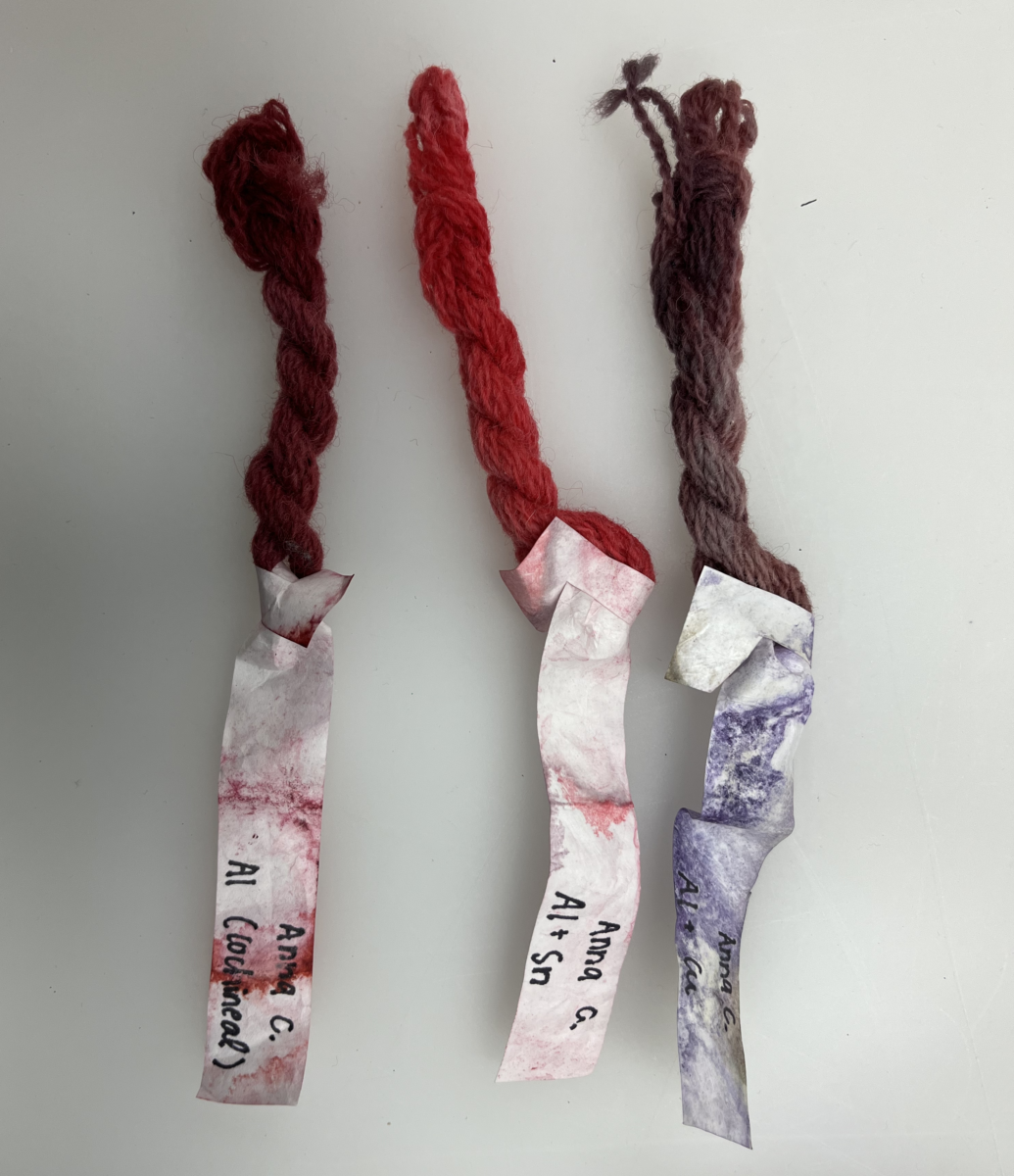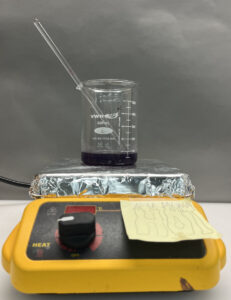Dyeing
Learning Objectives
- To understand the difference between pigments and dyes
- To experience processing a natural dye and dyeing natural fibers
- To understand how natural dyes were made historically
- To understand how additives such as mordants and fixatives affect the dye color
Curricular Tie-Ins
This dyeing workshop is a useful tool to introduce color analysis and some of the analytical methods that are used in technical art history.
Students will be able to answer the following questions:
- What tools and resources are available for technical art historians to conduct color analysis?
- Why is color analysis important in technical art history?

Dyed Yarn Skeins
Supplies
- Clean work space
- Mylar, newspaper paper (to protect work surface, if necessary)
- Nitrile gloves
- Apron
- Safety glasses
- Glass jar with lid
- Glass stirring rod
- Tweezers
- Undyed wool yarn
- Dried cochineal dye
- Alum powder
- Cream of tartar
- Blue vitriol (copper sulfate)
- Tin (II) chloride
- 2 plastic cups
- Hot Water
- Cold water
Steps
Before Class:
- Cut about 8 feet of the yarn and wrap into a miniature skein of yarn, each student should have 2 skeins
- Prepare centrifuge tubes: Fill up tubes to around the 1mL line with either alum powder, cream of tartar, tin chloride, or blue vitriol
- There should be one tube of alum for each glass jar
- There should be a tube of cream of tartar for half of the amount of jars
- Alternate between tin chloride and blue vitriol, each jar should have one or the other
- Note: some jars may have three vials (eg. 1 alum, 1 cream of tartar, and 1 of either tin chloride or blue vitriol)
- Fill paint pots with dried cochineal (one for each glass jar)
- Have a cup of hot water and a cup of cold water prepared before starting the workshop
- Prepare a clean workspace
Dyeing
- Add all of the dried cochineal to a glass jar
- Crush the cochineal slightly with a glass rod
- Fill the jar halfway with hot water
- Continue crushing the cochineal and stir, the water should begin to turn a red-violet/wine color
- Add the entire vile of alum to the jar and stir
- If you have a vial with cream of tartar add to the jar and stir
- Add one of the skeins of yarn to the jar, and stir
- Close the jar and let sit for at least 15 minutes (shake lightly once in a while to distribute dye
- Remove the skein of yarn with tongs and squeeze out the excess dye, set the yarn to the side
- Yarn should be a red-violet/wine color
- Add either tin chloride or blue vitriol to the jar and stir
- Add the second yarn skein to the jar and stir
- Close the jar and allow the dye and yarn to sit for at least 15 minutes
- Remove the yarn from the jar and squeeze out excess dye, set the yarn aside to dry
- If the jar had alum and cream of tartar, the color of the yarn on the dye should be vibrant
- If the jar had tin chloride the color of the yarn should be a pinkish or crimson
- If the jar had blue vitriol, the yarn should be a dark purple color
- Dye disposal:
- If the dye DOES NOT HAVE blue vitriol in it then the dye can be poured down the drain
- If the dye HAS blue vitriol in it then pour the dye onto paper towels, allow to dry, and throw them away. DO NOT pour blue vitriol down the drain.

Cochineal Dye with Tin Chloride
Tips
- Wear clothes that you do not mind getting dirty
- Make sure that the water used for the dye initially is hot, the warmer the water the stronger the dye
- Yarn can be left in dye longer than the time suggested for a stronger color
- Ensure that the lid is secured before shaking a jar with dye in it
Safety
- Do not eat or drink dyes/pigments
- Properly dispose of dyes when the workshop is completed
- Wear gloves and safety glasses when handling blue vitriol
Additional Materials
A list of Dutch painting with side-by-side Infrared Reflectography (IRR) images of their underdrawings from the National Gallery of Art
A brief video on the use of cochineal dye by weavers in Oaxaca, Mexico
Article on using mordants and fixatives with natural dyes
A guide on how to dye fabrics naturally using plant-based dyes
Article from the American Chemical Society on the chemistry of pigments and how scientists use chemistry to prevent pigment degradation.